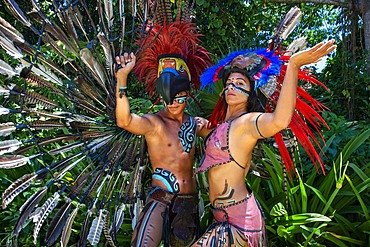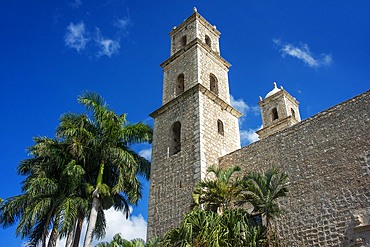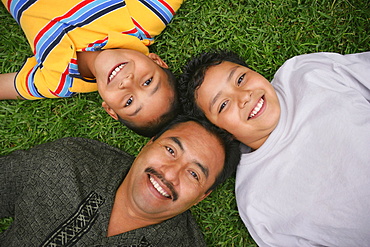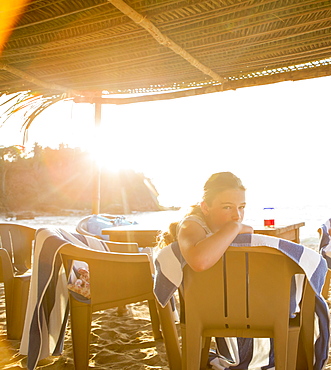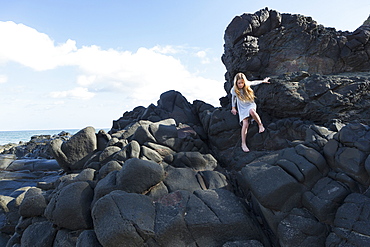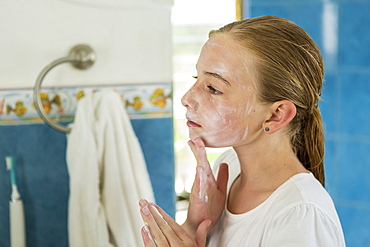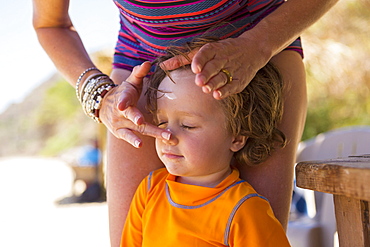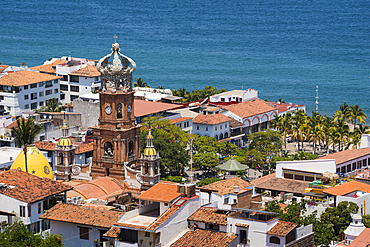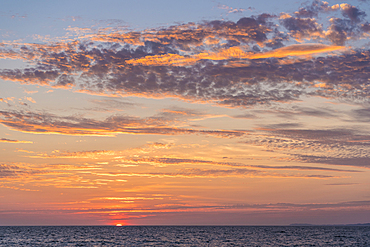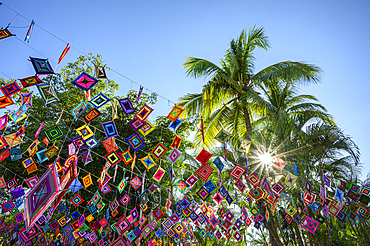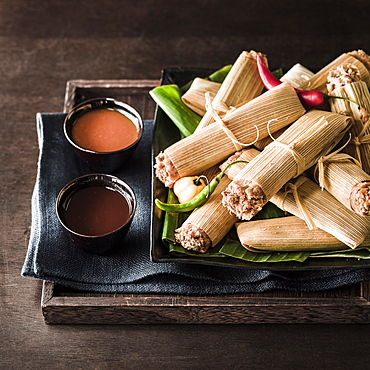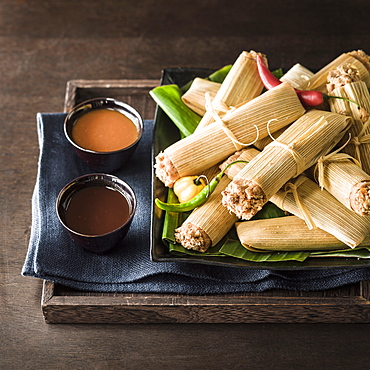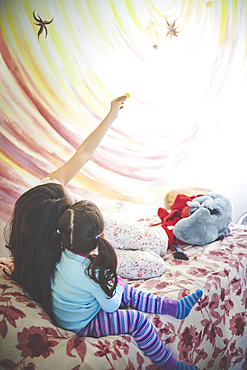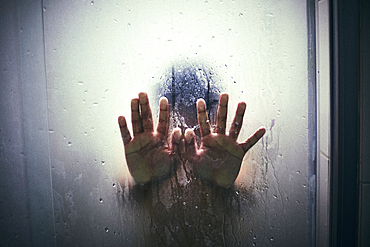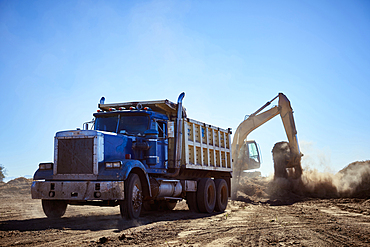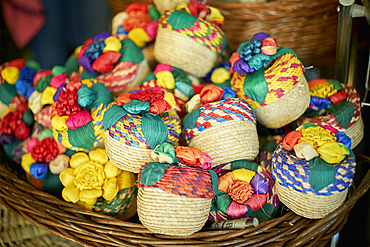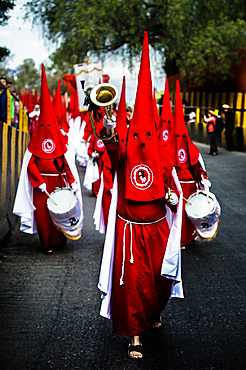Recent searches
Loading...
1350-6595 - Mexican aztec dress gods at Grand Palladium White Sand Resort and Spa in Riviera Maya, Yucatan Peninsula, Quintana Roo, Caribbean Coast, Mexico.
Aztec clothing was generally loose fitting and did not completely cover the body. When the Spanish arrived in Mexico, the people were surprised to see them in their full armour, with only their faces exposed.
Aztec clothes were generally made of cotton (which was imported) or ayate fiber, made from the Maguey Cactus (also called the Century Plant or American Aloe). Women would weave the fibers into clothing, a task girls were taught as young teenagers. Because of their vast trading network, the Aztecs were able to make use of a beautiful array of dyes, creating the brilliant
1350-6654 - The Parque Hidalgo and statue of Manuel Cepeda Peraza and The San Ildefonso Cathedral in Mérida, the capital and largest city in the Yucatan State and Yucatán Peninsula, Mexico
1350-6653 - Horse drawn carriages on a city street in front of the plaza grande square, Merida, the capital city of the Yucatan, Mexico Latin America
1350-6652 - The Bishop's Palace or Peninsula Athenaeum and The San Ildefonso Cathedral in Mérida, the capital and largest city in the Yucatan State and Yucatán Peninsula, Mexico
1350-6650 - Merida Mexico - the Merida city sign in the Plaza Grande, Merida, the capital city of the Yucatan, Mexico Latin America
1350-6649 - Portal Maya sculpture Mayan Gateway situated in Parque Fundadores by sculptor Jose Arturo Tavares in Playa del Carmen, Riviera Maya, Quintana Roo, Mexico
1350-6648 - White Mexican church and street art at 5th Avenue, Playa del Carmen, Caribe, Quintana Roo state, Mayan Riviera, Yucatan Peninsula, Mexico
1350-6646 - Colorful Mexican ceramic skulls or calaveras and Frida Kahlo souvenirs in Playa del Carmen, Riviera Maya, Quintana Roo, Mexico
1350-6645 - El Castillo, The Pyramid of Kukulkán, is the Most Popular Building in the UNESCO Mayan Ruin of Chichen Itza Archaeological Site Yucatan Peninsula, Quintana Roo, Caribbean Coast, Mexico
1350-6644 - The Church and Nunnery at Chichen Itza Archaeological Site in Yucatan Peninsula, Quintana Roo, Caribbean Coast, Mexico
1350-6643 - Stony stairs of tomb of the High Priest pyramid at Chichen Itza Archaeological Site in Yucatan Peninsula, Quintana Roo, Caribbean Coast, Mexico
1350-6642 - The Great Ball Court in the Mayan Ruins of Chichen Itza Archaeological Site Yucatan Peninsula, Quintana Roo, Caribbean Coast, Mexico
1350-6640 - Serpent head sculpture in Mayan Ruin of Chichen Itza Archaeological Site in Yucatan Peninsula, Quintana Roo, Caribbean Coast, Mexico
1350-6639 - El Castillo, The Pyramid of Kukulkán, is the Most Popular Building in the UNESCO Mayan Ruin of Chichen Itza Archaeological Site Yucatan Peninsula, Quintana Roo, Caribbean Coast, Mexico
1350-6637 - El Castillo, The Pyramid of Kukulkán, is the Most Popular Building in the UNESCO Mayan Ruin of Chichen Itza Archaeological Site Yucatan Peninsula, Quintana Roo, Caribbean Coast, Mexico. Asian tour leder dressed in a maya style.
1350-6638 - El Castillo, The Pyramid of Kukulkán, is the Most Popular Building in the UNESCO Mayan Ruin of Chichen Itza Archaeological Site Yucatan Peninsula, Quintana Roo, Caribbean Coast, Mexico
832-398199 - Mexican violetear (Colibri thalassinus), lives in the highlands, Cordillera de Talamanca, Costa Rica, Central America
832-398200 - Mexican violetear (Colibri thalassinus), with splayed purple feathers on the head, the violet ears, lives in the highlands, Cordillera de Talamanca, Costa Rica, Central America
832-398149 - French Bulldog dog wearing pink sunglasses and Mexican straw hat
832-398169 - Mexico logo at the international airport in Mexico
832-397709 - Travel Mexico background, Anicent Maya mayan pyramid El Castillo (Kukulkan) in Chichen-Itza, Mexico, Central America
1242-499 - Playa Zicatela, the legendary Mexican surfing beach, stretching for over 3 km, Oaxaca, Mexico, North America
1178-43268 - Caucasian girl sitting in chair at beach
1178-43264 - Caucasian girl climbing rocks at beach
1178-43270 - Caucasian mother applying sunscreen to face of son
1178-43269 - Caucasian woman holding two bottles of beer
1178-43129 - Smiling Hispanic women wearing sunglasses
832-396482 - Original Mexican quesadilla de pollo with nachos served with gazpacho soup and watermelon, with fresh vegetables on background
809-8348 - Mexican wall art in Quito, Ecuador, South America
1350-6372 - Our Lady of Guadalupe Cathedral and the plaza in downtown Puerto Vallarta, Jalisco, Mexico.
1350-6331 - Peacock displaying tail feathers at Velas Vallarta Hotel, Puerto Vallarta, Jalisco, Mexico.
1350-6365 - Interior of Parroquia de San Blas, the Catholic church on the main plaza in San Blas, Riviera Nayarit, Mexico.
1350-6370 - Agave at El Charco del Ingenio Botanical Garden, San Miguel de Allende, Guanajuato, Mexico.
1350-6310 - Chile peppers in the mercado in San Blas, Riviera Nayarit, Mexico.
1350-6355 - Papel picado flags on the plaza in San Blas, Riviera Nayarit, Mexico.
1350-6351 - Sunset over Bay of Banderas from the Malecon in Puerto Vallarta, Jalisco, Mexico.
1350-6329 - Parroquia de San Blas, the Catholic church on the main plaza in San Blas, Riviera Nayarit, Mexico.
1350-6366 - Ojo de Dios in Sayulita, Riviera Nayarit, Mexico.
1350-6307 - Margarita time at Pelicanos Restaurant. Puerto Morelos, Riviera Maya, Mexico.
801-3119 - Merida Sign, Mexican flag, Plaza Grande, Cathedral de IIdefonso in the background, Merida, Yucatan State, Mexico, North America
801-3120 - Mexican flag, Plaza Grande, Cathedral de IIdefonso in the background, Merida, Yucatan State, Mexico, North America
1178-42186 - Bowl of Mexican tortilla casserole with corn
1178-42067 - Bowl of tortilla chips and pico de gallo
1178-41735 - Hand of Hispanic woman holding makeup brush
1178-41729 - Hispanic boy helping father spray cleaner on table
1178-41737 - Hispanic mother and daughter on bed looking at mural on wall
1178-41736 - Hispanic mother holding smiling daughter
1178-41309 - Hispanic boy swimming with swimming cap and goggles
1178-41738 - Hispanic mother and daughter on bed looking down
1178-41308 - Hispanic boy swimming with swimming cap and goggles
1178-41307 - Hands of Hispanic boy leaning on shower door
1178-41730 - Hispanic girl cleaning table with towel
1178-41734 - Hispanic woman using makeup brush in mirror
1178-39435 - Multicolor maracas in shop in Guadalajara, Jalisco, Mexico
1178-39434 - Maracas and slingshots in shop in Guadalajara, Jalisco, Mexico
1350-5075 - Other participants include adults and children in various dress which include altar boys, Nazarenes,
1350-5170 - For almost 60 years, about two thousand people from 28 different guilds (associations of faithful Catholics) come together on Good Friday to participate in this procession, carrying emblems, religious images concerning the Stations of the Cross, and dressed in the distinctive colors of their guilds, Each one of the ,??Guilds,?? carries an image with a picture of Jesus Christ,??s Stations of the Cross and of the mysteries of the Holy Rosary,
1350-5328 - Attractive young mixed race woman listening to music in Central Park, New York City
1350-5273 - Among them there are also differences Nazarenes, some are barefoot and harder doing his penance, others bearing crosses, there are those who carry various representative elements of the brotherhood, musical objects, candles, etc,
1350-4702 - Group of the Thousand Columns, Chichen Itza Archaeological Site, Chichen Itza, Yucatan State, Mexico
1350-5256 - For almost 60 years, about two thousand people from 28 different guilds (associations of faithful Catholics) come together on Good Friday to participate in this procession, carrying emblems, religious images concerning the Stations of the Cross, and dressed in the distinctive colors of their guilds, Each one of the ,??Guilds,?? carries an image with a picture of Jesus Christ,??s Stations of the Cross and of the mysteries of the Holy Rosary,
1350-5124 - Women wearing traditional Potosi rebozos and carrying candles,
1350-5140 - Among them there are also differences Nazarenes, some are barefoot and harder doing his penance, others bearing crosses, there are those who carry various representative elements of the brotherhood, musical objects, candles, etc,
1350-5343 - Attractive young mixed race woman traveling in subway train, New York City
1350-5118 - Women wearing traditional Potosi rebozos and carrying candles,
